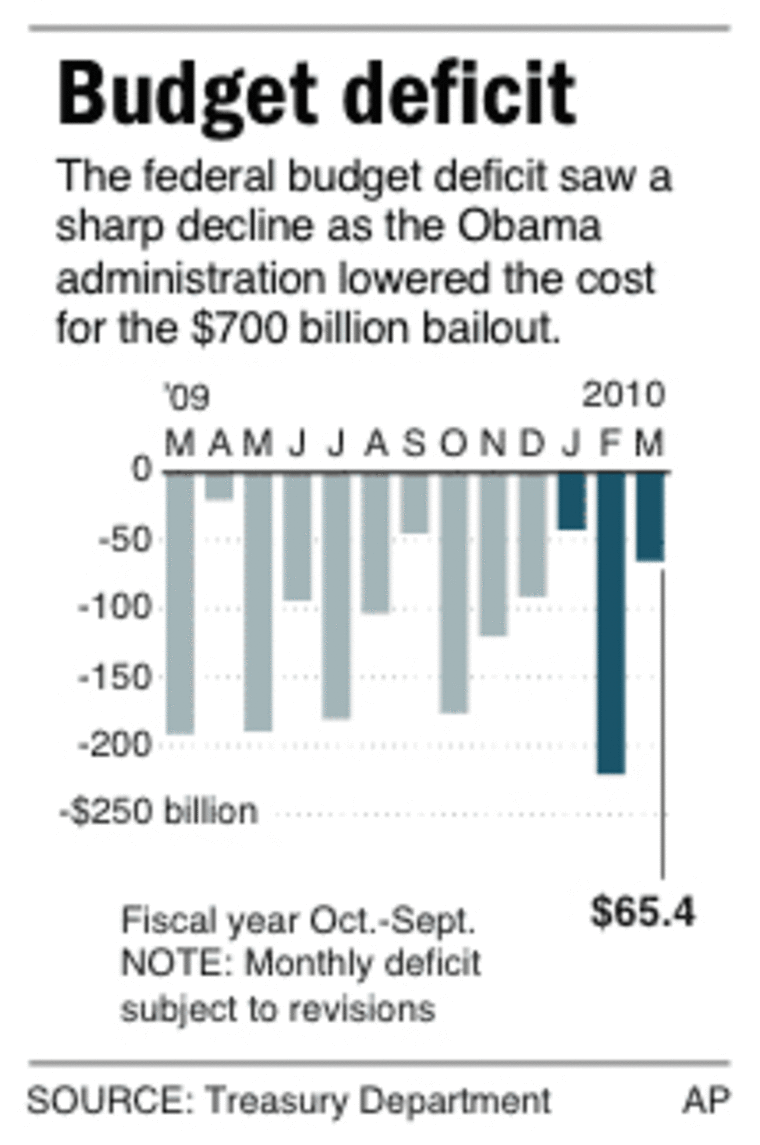The federal deficit is running significantly lower than it did last year, with the budget gap for the first half of fiscal 2010 down 8 percent over the same period a year ago, senior Obama administration officials said Monday.
The officials attributed the results to higher tax revenue and to lower spending than projected on bailing out the financial system. If the trend continues for the rest of the year, it would mean the annual deficit would be $1.3 trillion -- about $300 billion less than the administration's projection two months ago for 2010.
But by suggesting the deficit may have peaked, administration officials are taking a political gamble.
If the favorable number does not hold up in coming months and the budget shortfall surpasses the $1.4 trillion recorded last year, voters in the November midterm elections could punish the Democrats for offering false hope.
No official statement on the deficit is scheduled until the release of a late-summer review. The officials spoke on the condition of anonymity because the findings are preliminary and the results for the full year might not turn out so well.
The officials expressed cautious optimism about the figures but noted that the outlook remains uncertain. Although the economy has stabilized, growth has been lackluster.
Ballooning deficit
If the administration and Congress pursue a new round of measures to stimulate the economy, these could boost government spending. Officials also want to see whether the favorable trend in tax collections recorded in February and March holds up through the April tax season.
The improved budget figure comes at an opportune time for Democrats as they head into a difficult political campaign, with Republicans blaming the administration for running up record deficits.

The federal deficit was large when Obama took office, but it ballooned as the administration launched an ambitious stimulus program to soften the economic downturn, which was eating tax revenue and prompting increased spending on safety net programs.
In recent days, Federal Reserve Chairman Ben S. Bernanke has added his voice to those of other prominent economic figures warning about the long-term dangers posed by large deficits.
A senior administration official acknowledged that the lower deficit number would not substantially ease the budget problems facing the government. But the favorable trend could allow Democrats to say they have turned the corner, and the number is one they would want to highlight for voters souring on Obama because of the government's red ink.
Administration officials said the favorable figure for the first half of the fiscal year, which began in October, reflected several factors.
Bailouts costing less
Taxes paid from corporations and withheld from individual paychecks were up February and March, compared with the same months last year, Treasury officials said Monday. This uptick reversed 21 months of year-over-year declines and, an official said, suggested that more Americans are getting back to work or earning higher salaries.
Government initiatives to bail out the financial system are also costing far less than officials had expected. The deficit figure for March, for instance, was down sharply from a year earlier, and most of that reduction came from a lower estimated cost for the Troubled Assets Relief Program, according to a Treasury report.
During the six months that ended in March, $10 billion was spent out of TARP. In contrast, that bailout program spent $186 billion for the same period ending March 2009. A separate program to aid mortgage financiers Fannie Mae and Freddie Mac used $25 billion in taxpayer dollars in the six months ending in March, compared with $119 billion for the same period a year ago.
The deficit figure released by the Treasury Department for March means that the federal government has been spending more than it collected for a record 18 consecutive months, dating to the Bush administration.
With a brighter outlook on the deficit, bond analysts predicted that Treasury would sell fewer government bonds over the rest of the year to cover the gap between spending and revenue. Last year, the auction of Treasury bonds provided a net increase in government borrowing of more than $1.2 trillion. This year, the figure could decline significantly, two analysts predicted.
Treasury officials declined to comment on bond sales, but they are scheduled at month's end to release their plan for Treasury auctions over the rest of the year.
The White House proposed a budget in February that projects a budget gap of $8.5 trillion over the next 10 years. Obama's senior officials have argued that the huge outlays are essential to pull the economy out of its worst recession in generations. But Republicans say the administration's stimulus programs have not significantly reduced the jobless rate, now at 9.7 percent.
The Congressional Budget Office has estimated that under Obama's policies, the 10-year deficit will hit nearly $10 trillion.